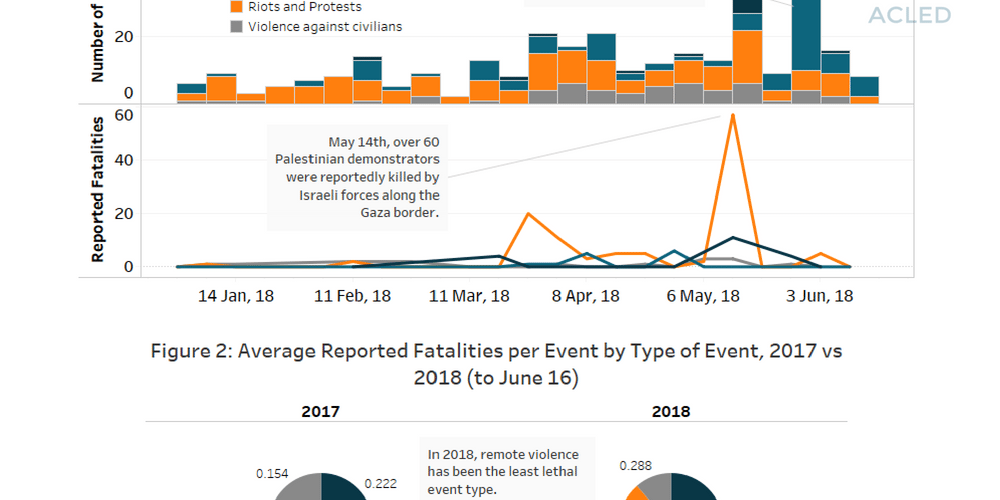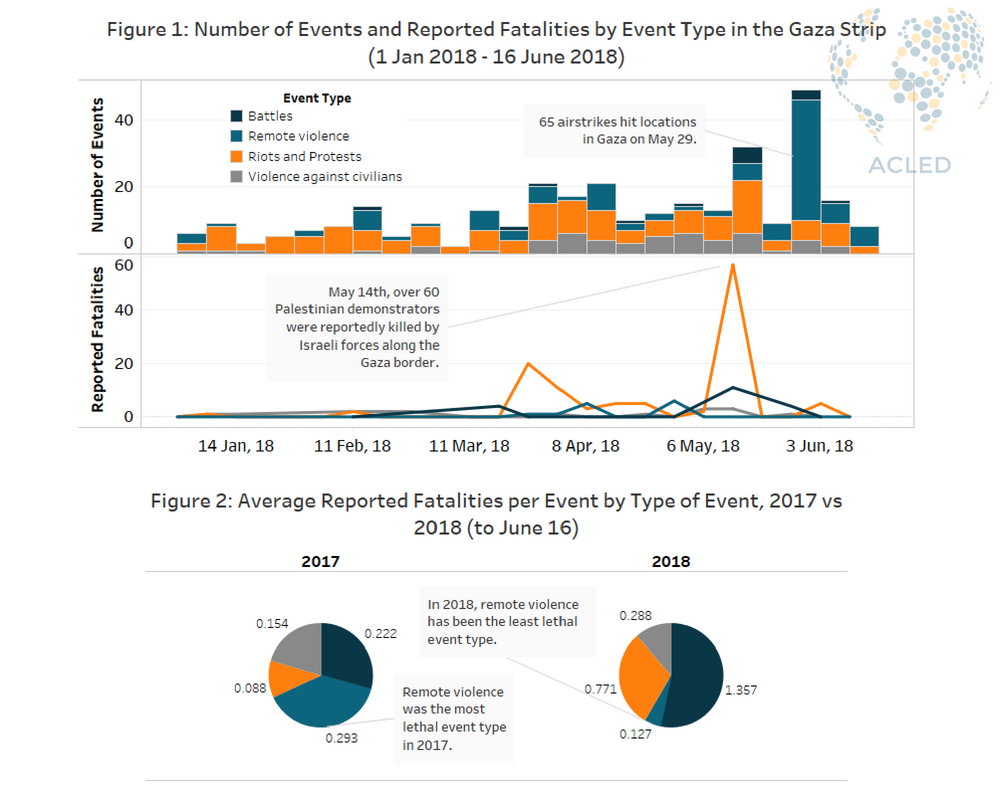Following international condemnation of Israel’s use of force against demonstrators (for more on this, see this past ACLED piece), Israeli forces have begun to use strategic airstrikes on Hamas infrastructure as a means of pressuring the group to better control border demonstrations in the Gaza Strip. This non-lethal use of airstrikes contrasts with historical data, which shows past Israeli airstrikes as being particularly deadly.
On May 29, Israeli forces stated that over 100 rockets and mortars were launched from the Gaza Strip into Israel in retaliation following the deaths of three Palestinian Islamic Jihad (PIJ) members. This attack sparked the most active cross-fire since the 2014 war (New York Times, 29 May 2018). Most of these projectiles were intercepted by the Iron Dome missile defense system. Hamas and PIJ jointly claimed responsibility for these projectiles — a rare level of cooperation between the two armed groups. Meanwhile, Israeli forces stated that they hit 65 Hamas targets in the Gaza Strip, primarily sites thought to be used for the storage and manufacturing of weapons, as well as training facilities (Arutz Sheva, 30 May 2018). Neither the mortars nor the airstrikes have resulted in any reported fatalities.
Israeli airstrikes in the Gaza Strip are a frequent occurrence. Figure 1 shows the consistency of airstrikes in 2018, with almost every week having at least one reported occurrence. Despite the recent spike, airstrikes in Gaza resulted in less than 10 reported fatalities in April and none in May or June thus far. This is in contrast to 2017 during which airstrikes were the most lethal event type and so far in 2018 they are the least lethal event type (see Figure 2). Historically, airstrikes have been the most lethal form of violence in the Gaza Strip. This was particularly evident in 2014 when over 2,000 Palestinians were killed, primarily by airstrikes (The Independent, 27 August 2014).
The drop in airstrike lethality in 2018 compared to 2017, as shown in Figure 2, supports claims that Israel is trying to pressure Hamas into controlling demonstrations by conducting non-lethal airstrikes as a means to cause substantial material damage to its facilities (Times of Israel, 16 May 2018). The high number of airstrikes alongside a lack of fatalities shows that the airstrikes are targeting Hamas infrastructure rather than populated areas, which is likely a tactical move to strong-arm Hamas to step up their control over the demonstrations if they want the airstrikes to stop. However, it remains unclear whether Hamas has the ability, capacity, and/or desire to stop the demonstrations. While data shows that demonstrations have decreased slightly, it is unclear whether this can be attributed to Hamas, to the conclusion of Ramadan and Eid celebrations, or due to the high number of fatalities on May 14th which likely dissuaded many from taking part in further demonstrations.
Many of the airstrikes over the past week have specifically targeted the new phenomenon of ‘fire kites’, which have caused fires in southern Israel. These ‘fire kites’ comprise of petrol bombs (commonly known as Molotov cocktails) that are attached to kites or balloons and then sent over the fence separating Gaza and Israel. In a recent release, senior Israeli military officials stated that they are not trying to target kite makers because this would result in too many casualties, and are instead directing attacks at Hamas infrastructure (Haaretz, 17 June 2018). While a number of attacks in recent weeks have been aimed specifically at kite builders, they have reportedly not been fatal, suggesting they are intended to act as a deterrence.
AnalysisCivilians At RiskConflict MonitoringCurrent HotspotsMiddle EastPolitical StabilityRemote ViolenceRioting And ProtestsViolence Against Civilians







